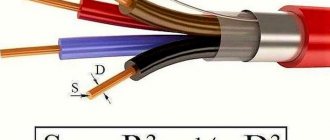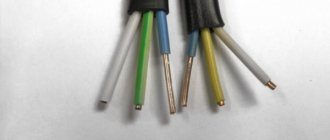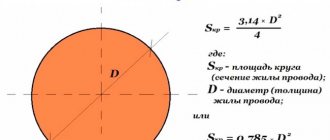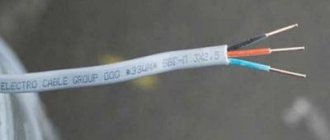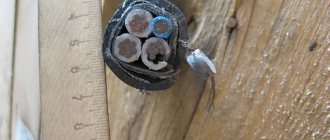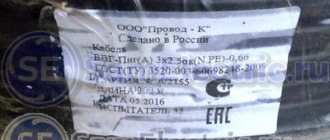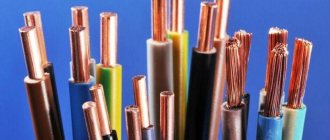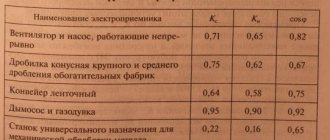Often, before purchasing cable products, there is a need to independently measure its cross-section in order to avoid deception on the part of manufacturers, who, due to savings and setting a competitive price, may slightly underestimate this parameter.
Variety of cable products and wires
It is also necessary to know how the cable cross-section is determined, for example, when adding a new energy-consuming point in rooms with old electrical wiring that does not have any technical information. Accordingly, the question of how to find out the cross-section of conductors always remains relevant.
General information about cable and wire
When working with conductors, it is necessary to understand their designation. There are wires and cables that differ from each other in their internal structure and technical characteristics. However, many people often confuse these concepts.
A wire is a conductor that has in its design one wire or a group of wires woven together and a thin common insulating layer. A cable is a core or a group of cores that has both its own insulation and a common insulating layer (sheath).
Each type of conductor will have its own methods for determining cross sections, which are almost similar.
Conductor materials
The amount of energy that a conductor transmits depends on a number of factors, the main one of which is the material of the current-carrying conductors. The following non-ferrous metals can be used as the core material of wires and cables:
- Aluminum. Cheap and lightweight conductors, which is their advantage. They are characterized by such negative qualities as low electrical conductivity, a tendency to mechanical damage, high transient electrical resistance of oxidized surfaces;
- Copper. The most popular conductors, which have a high cost compared to other options. However, they are characterized by low electrical and transition resistance at the contacts, fairly high elasticity and strength, and ease of soldering and welding;
- Aluminum copper. Cable products with aluminum cores coated with copper. They are characterized by slightly lower electrical conductivity than their copper counterparts. They are also characterized by lightness, average resistance and relative cheapness.
Various types of cables according to core material
Important! Some methods for determining the cross-section of cables and wires will depend specifically on the material of their conductor component, which directly affects the throughput power and current strength (method of determining the cross-section of conductors by power and current).
Measuring the cross-section of conductors by diameter
Conductor cross section
There are several ways to determine the cross-section of a cable or wire. The difference in determining the cross-sectional area of wires and cables will be that in cable products it is necessary to measure each core separately and summarize the indicators.
For information. When measuring the parameter under consideration with instrumentation, it is necessary to initially measure the diameters of the conductive elements, preferably removing the insulating layer.
Instruments and measurement process
The measuring instruments can be a caliper or a micrometer. Mechanical devices are usually used, but electronic analogues with a digital screen can also be used.
Appearance of a mechanical micrometer
Basically, the diameter of wires and cables is measured using a caliper, since it is found in almost every household. It can also measure the diameter of wires in a working network, for example, a socket or panel device.
Measuring the diameter with a mechanical caliper
The diameter of the wire cross-section is determined using the following formula:
S = (3.14/4)*D2, where D is the diameter of the wire.
If the cable contains more than one core, then it is necessary to measure the diameter and calculate the cross-section using the above formula for each of them, then combine the result obtained using the formula:
Stotal= S1 + S2 +…+Sn, where:
- Stotal – total cross-sectional area;
- S1, S2, …, Sn – cross sections of each core.
On a note. To ensure the accuracy of the results obtained, it is recommended to take measurements at least three times, turning the conductor in different directions. The result will be the average.
Determining the diameter of the vein with a digital caliper
In the absence of a caliper or micrometer, the diameter of the conductor can be determined using a regular ruler. To do this, you need to perform the following manipulations:
- Clean the insulating layer of the core;
- Wind the turns around the pencil tightly to each other (there should be at least 15-17 pieces);
- Measure the winding length;
- Divide the resulting value by the number of turns.
Important! If the turns are not laid evenly on the pencil with gaps, then the accuracy of the obtained results of measuring the cable cross-section by diameter will be in doubt. To increase the accuracy of measurements, it is recommended to take measurements from different sides. It will be difficult to wind thick wires onto a simple pencil, so it is better to resort to a caliper.
After measuring the diameter, the cross-sectional area of the wire is calculated using the formula described above or determined using a special table, where each diameter corresponds to the cross-sectional area.
Measuring the diameter of a conductor product using a ruler
It is better to measure the diameter of the wire, which contains ultra-thin cores, with a micrometer, since a caliper can easily break it.
The easiest way to determine the cable cross-section by diameter is using the table below.
Table of correspondence between wire diameter and wire cross-section
| Diameter of conductor element, mm | Cross-sectional area of the conductor element, mm2 |
| 0,8 | 0,5 |
| 0,9 | 0,63 |
| 1 | 0,75 |
| 1,1 | 0,95 |
| 1,2 | 1,13 |
| 1,3 | 1,33 |
| 1,4 | 1,53 |
| 1,5 | 1,77 |
| 1,6 | 2 |
| 1,8 | 2,54 |
| 2 | 3,14 |
| 2,2 | 3,8 |
| 2,3 | 4,15 |
| 2,5 | 4,91 |
| 2,6 | 5,31 |
| 2,8 | 6,15 |
| 3 | 7,06 |
| 3,2 | 7,99 |
| 3,4 | 9,02 |
| 3,6 | 10,11 |
| 4 | 12,48 |
| 4,5 | 15,79 |
How to calculate the cross-section of a stranded wire
Stranded wire, or as it is also called stranded or flexible, is a single-core wire twisted together. To calculate the cross-section of a stranded wire, you must first calculate the cross-section of one wire, and then multiply the resulting result by their number.
Let's look at an example. There is a multi-core flexible wire, in which there are 15 cores with a diameter of 0.5 mm. The cross-section of one core is 0.5 mm × 0.5 mm × 0.785 = 0.19625 mm2, after rounding we get 0.2 mm2. Since we have 15 wires in the wire, to determine the cable cross-section we need to multiply these numbers. 0.2 mm2×15=3 mm2. It remains to determine from the table that such a stranded wire will withstand a current of 20 A.
You can estimate the load capacity of a stranded wire without measuring the diameter of an individual conductor by measuring the total diameter of all twisted wires. But since the wires are round, there are air gaps between them. To eliminate the gap area, you need to multiply the result of the wire cross-section obtained from the formula by a factor of 0.91. When measuring the diameter, you need to make sure that the stranded wire does not flatten.
Let's look at an example. As a result of measurements, the stranded wire has a diameter of 2.0 mm. Let's calculate its cross-section: 2.0 mm × 2.0 mm × 0.785 × 0.91 = 2.9 mm2. Using the table (see below), we determine that this stranded wire will withstand a current of up to 20 A.
Segment cable cross-section
What is the difference between a cable and a wire?
Cable products with a cross-section of up to 10 mm2 are almost always produced in a round shape. Such conductors are quite sufficient to meet the domestic needs of houses and apartments. However, with a larger cross-section of the cable, the input cores from the external electrical network can be made in segment (sector) form, and it will be quite difficult to determine the cross-section of the wire by diameter.
Aluminum cable with sector conductors
In such cases, it is necessary to resort to a table where the size (height, width) of the cable takes the corresponding value of the cross-sectional area. Initially, it is necessary to measure the height and width of the required segment with a ruler, after which the required parameter can be calculated by correlating the obtained data.
Table for calculating the area of an electric cable core sector
| Cable type | Sectional area of the segment, mm2 | ||||||||
| S | 35 | 50 | 70 | 95 | 120 | 150 | 185 | 240 | |
| Four-core segment | V | — | 7 | 8,2 | 9,6 | 10,8 | 12 | 13,2 | — |
| w | — | 10 | 12 | 14,1 | 16 | 18 | 18 | — | |
| Three-core segmental stranded, 6(10) | V | 6 | 7 | 9 | 10 | 11 | 12 | 13,2 | 15,2 |
| w | 10 | 12 | 14 | 16 | 18 | 20 | 22 | 25 | |
| Three-core segmental single-wire, 6(10) | V | 5,5 | 6,4 | 7,6 | 9 | 10,1 | 11,3 | 12,5 | 14,4 |
| w | 9,2 | 10,5 | 12,5 | 15 | 16,6 | 18,4 | 20,7 | 23,8 | |
Dependence of current, power and core cross-section
It is not enough to measure and calculate the cross-sectional area of the cable based on the diameter of the core. Before installing wiring or other types of electrical networks, it is also necessary to know the capacity of the cable products.
Wires for electrical wiring
When choosing a cable, you must be guided by several criteria:
- the strength of the electric current that the cable will pass;
- power consumed by energy sources;
- current load exerted on the cable.
Power
The most important parameter during electrical installation work (in particular, cable laying) is throughput. The maximum power of electricity transmitted through it depends on the cross-section of the conductor. Therefore, it is extremely important to know the total power of the energy consumption sources that will be connected to the wire.
Typically, manufacturers of household appliances, appliances and other electrical products indicate on the label and in the documentation accompanying them the maximum and average power consumption. For example, a washing machine can consume electricity ranging from tens of W/h during rinsing mode to 2.7 kW/h when heating water. Accordingly, a wire with a cross-section that is sufficient to transmit electricity of maximum power must be connected to it. If two or more consumers are connected to the cable, then the total power is determined by adding the limit values of each of them.
The average power of all electrical appliances and lighting devices in an apartment rarely exceeds 7500 W for a single-phase network. Accordingly, the cable cross-sections in the electrical wiring must be selected to this value.
On a note. It is recommended to round the cross-section towards higher power due to a possible increase in power consumption in the future. Typically, the next largest cross-sectional area from the calculated value is taken.
So, for a total power of 7.5 kW, it is necessary to use a copper cable with a core cross-section of 4 mm2, which is capable of transmitting about 8.3 kW. The cross-section of the conductor with an aluminum core in this case must be at least 6 mm2, passing a current power of 7.9 kW.
Marking labels for electrical appliances and household appliances indicating their rated power
In individual residential buildings, a three-phase power supply system of 380 V is often used. However, most equipment is not designed for such electrical voltage. A voltage of 220 V is created by connecting them to the network through a neutral cable with an even distribution of the current load across all phases.
Electric current
Often the power of electrical equipment and equipment may not be known to the owner due to the absence of this characteristic in the documentation or completely lost documents and labels. There is only one way out in such a situation - to calculate using the formula yourself.
Power is determined by the formula:
P = U*I, where:
- P – power, measured in watts (W);
- I – electric current strength, measured in amperes (A);
- U is the applied electrical voltage, measured in volts (V).
When the strength of the electric current is unknown, it can be measured with control and measuring instruments: an ammeter, a multimeter, and a clamp meter.
Measuring current with clamp meters
After determining the power consumption and electric current, you can use the table below to find out the required cable cross-section.
Load
Calculation of the cross-section of cable products based on current load must be carried out to further protect them from overheating. When too much electric current passes through conductors for their cross-section, destruction and melting of the insulating layer can occur.
The maximum permissible long-term current load is the quantitative value of the electric current that can pass the cable for a long time without overheating. To determine this indicator, it is initially necessary to sum up the powers of all energy consumers. After this, calculate the load using the formulas:
- I = P∑*Ki/U (single-phase network),
- I = P∑*Kи/(√3*U) (three-phase network), where:
- P∑ – total power of energy consumers;
- Ki – coefficient equal to 0.75;
- U – electrical voltage in the network.
Table of correspondence between the cross-sectional area of copper conductors of conductor products and current and power *
| Section of cable and wire products | Electrical voltage 220 V | Electrical voltage 380 V | ||
| Current strength, A | power, kWt | Current strength, A | power, kWt | |
| 2,5 | 27 | 5,9 | 25 | 16,5 |
| 4 | 38 | 8,3 | 30 | 19,8 |
| 6 | 50 | 11 | 40 | 26,4 |
| 10 | 70 | 15,4 | 50 | 33 |
| 16 | 90 | 19,8 | 75 | 49,5 |
| 25 | 115 | 25,3 | 90 | 59,4 |
| 35 | 140 | 30,8 | 115 | 75,9 |
| 50 | 175 | 38,5 | 145 | 95,7 |
| 70 | 215 | 47,3 | 180 | 118,8 |
| 95 | 260 | 57,2 | 220 | 145,2 |
| 120 | 300 | 66 | 260 | 171,6 |
* Important! Conductors with aluminum conductors have different values.
Determining the cross-section of a cable product is a particularly important process in which miscalculations are unacceptable. You need to take into account all factors, parameters and rules, trusting only your calculations. The measurements taken must coincide with the tables described above - if they do not contain specific values, they can be found in the tables of many electrical engineering reference books.
Calculation of the cross-section of electrical wiring according to the power of connected electrical appliances
To select the cross-section of cable wire cores when laying electrical wiring in an apartment or house, you need to analyze the fleet of existing electrical household appliances from the point of view of their simultaneous use. The table provides a list of popular household electrical appliances indicating the current consumption depending on the power.
You can find out the power consumption of your models yourself from the labels on the products themselves or data sheets; often the parameters are indicated on the packaging. If the current consumed by an electrical appliance is not known, it can be measured using an ammeter.
Table of power consumption and current for household electrical appliances at a supply voltage of 220 V
Typically, the power consumption of electrical appliances is indicated on the housing in watts (W or VA) or kilowatts (kW or kVA). 1 kW=1000 W.
Table of power/current consumption of household electrical appliances
| electrical appliance | Power consumption, W | Current strength, A |
| Washing machine | 2000 – 2500 | 9,0 – 11,4 |
| Jacuzzi | 2000 – 2500 | 9,0 – 11,4 |
| Electric floor heating | 800 – 1400 | 3,6 – 6,4 |
| Stationary electric stove | 4500 – 8500 | 20,5 – 38,6 |
| microwave | 900 – 1300 | 4,1 – 5,9 |
| Dishwasher | 2000 – 2500 | 9,0 – 11,4 |
| Freezers, refrigerators | 140 – 300 | 0,6 – 1,4 |
| Electric meat grinder | 1100 – 1200 | 5,0 – 5,5 |
| Electric kettle | 1850 – 2000 | 8,4 – 9,0 |
| Electric coffee maker | 630 – 1200 | 3,0 – 5,5 |
| Juicer | 240 – 360 | 1,1 – 1,6 |
| Toaster | 640 – 1100 | 2,9 – 5,0 |
| Mixer | 250 – 400 | 1,1 – 1,8 |
| Hairdryer | 400 – 1600 | 1,8 – 7,3 |
| Iron | 900 –1700 | 4,1 – 7,7 |
| Vacuum cleaner | 680 – 1400 | 3,1 – 6,4 |
| Fan | 250 – 400 | 1,0 – 1,8 |
| TV | 125 – 180 | 0,6 – 0,8 |
| Radio equipment | 70 – 100 | 0,3 – 0,5 |
| Lighting devices | 20 – 100 | 0,1 – 0,4 |
Current is also consumed by the refrigerator, lighting fixtures, radiotelephone, chargers, and TV in standby mode. But in total this power is no more than 100 W and can be ignored in calculations.
If you turn on all the electrical appliances in the house at the same time, you will need to select a wire cross-section capable of passing a current of 160 A. You will need a finger-thick wire! But such a case is unlikely. It’s hard to imagine that someone is capable of grinding meat, ironing, vacuuming and drying hair at the same time.
Calculation example. You got up in the morning, turned on the electric kettle, microwave, toaster and coffee maker. The current consumption will accordingly be:
7 A + 8 A + 3 A + 4 A = 22 A
Taking into account the switched on lighting, refrigerator and, in addition, for example, a TV, the current consumption can reach 25 A.
Selecting a wire cross-section for connecting electrical appliances to a three-phase 380 V network
When operating electrical appliances, for example, an electric motor, connected to a three-phase network, the consumed current no longer flows through two wires, but through three and, therefore, the amount of current flowing in each individual wire is somewhat less. This allows you to use a smaller cross-section wire to connect electrical appliances to a three-phase network.
To connect electrical appliances to a three-phase network with a voltage of 380 V, for example an electric motor, the wire cross-section for each phase is taken 1.75 times less than for connecting to a single-phase 220 V network. Attention, when choosing the wire cross-section for connecting an electric motor by power, you should take into account that The motor nameplate indicates the maximum mechanical power that the motor can produce at the shaft, not the electrical power consumed.
The electrical power consumed by the electric motor, taking into account efficiency and cos φ, is approximately two times greater than that created on the shaft, which must be taken into account when choosing the wire cross-section based on the motor power indicated on the plate.
For example, you need to connect an electric motor that consumes power from a 2.0 kW network. The total current consumption of an electric motor of such power in three phases is 5.2 A. According to the table, it turns out that a wire with a cross-section of 1.0 mm2 is needed, taking into account the above 1.0 / 1.75 = 0.5 mm2. Therefore, to connect a 2.0 kW electric motor to a three-phase 380 V network, you will need a three-core copper cable with a cross-section of each core of 0.5 mm2.
It is much easier to choose the wire cross-section for connecting a three-phase motor based on the current consumption, which is always indicated on the nameplate. For example, the current consumption of a 0.25 kW motor for each phase at a supply voltage of 220 V (the motor windings are connected in a delta configuration) is 1.2 A, and at a voltage of 380 V (the motor windings are connected in a star configuration) it is only 0.7 A.
Taking the current strength indicated on the nameplate, according to the table for selecting the wire cross-section for apartment electrical wiring, we select a wire with a cross-section of 0.35 mm2 when connecting the electric motor windings in a “triangle” pattern or 0.15 mm2 when connecting in a “star” pattern.
